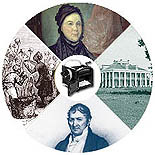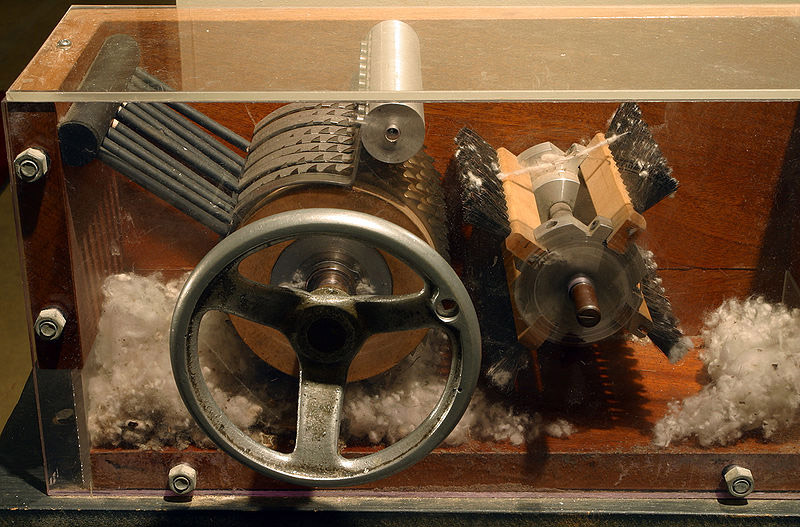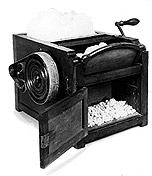Activity: Who Invented the Cotton Gin?
 (Courtesy of the Lemelson Center for the Study of Invention and Innovation, National Museum of American History, Smithsonian Institution)
(Courtesy of the Lemelson Center for the Study of Invention and Innovation, National Museum of American History, Smithsonian Institution)
Level: Grades 6-12; Time needed: approximately 45-60 minutes
The invention of the cotton gin, a device that separates cotton fibers from the seeds, is typically attributed to Eli Whitney, who was granted the patent in 1794. Yet, others contributed to its making — including a woman, Catherine Greene, and African slaves, two groups that gained little recognition for their input. In fact, the gin’s invention supported the growth of cotton industry and slave economy in 19th-century America. During Black History month, as schools recognize the contributions of African-Americans to society, this activity offers a way to consider people who might have been overlooked by history, as well as the complex politics that governed the plantation economy.

Inventing the Cotton Gin: A Class Debate
Description:
Students debate who invented the cotton gin after reading the student essay “Why A Plantation?” about four claims to the gin’s invention. They come to realize the complexity of what may seem like a simple historical statement found in most social studies textbooks: “Eli Whitney invented the cotton gin.” A follow-up group discussion is guided by included questions about the nature of invention, the importance of history, and the nature of historical evidence.
Learning Outcomes and Skills:
1. Students realize that invention is a complicated and contested process.
2. Students learn about the nature of historical evidence and how to construct a historical argument.
3. Students learn that when profitable patents and historical credit get assigned, people without power (like African Americans and women) may be overlooked.
Process:
Divide students into five groups, one for each of the parties that claims to have invented the cotton gin, and one group to represent the patent examiner, who will decide who should get credit for the invention. All students need to read the student essay “Why A Plantation?” and the materials contained in the Student Activity Packet which give background information and specifics about each inventor. Each group makes a presentation, arguing that they deserve the credit and then the patent examiner makes a decision. A class discussion follows.
Materials:
Copies of the student essay and the Student Activity Packet for each student.
ADDITIONAL INFORMATION
On the debate: There is no right answer to the question “Who invented the cotton gin?” There really are good arguments on all sides — and these are issues that are still of concern to inventors today.
Possible arguments:
For the Eli Whitney group:
• Whitney should get credit because he did the legal work to get the patent.
• Whitney should get credit because he pulled together all the ideas.
• Just giving advice to the inventor doesn’t count–people give advice all the time. The trick is knowing what advice to take.
• Just having the idea is not enough–following through is important.
For the Catharine Greene group:
• The idea is the most important part of an invention.
• Whitney was working for Greene, so she should get the rights to whatever patents he gets.
• Greene introduced Whitney to the problem, and got him started in the right direction, which is the hardest part of inventing something.
For the African Slaves group:
• Slaves were used to dealing with the problem, and so had the detailed knowledge of materials and processes necessary to solve it.
• Slaves pointed out the problem, which is the hardest part of inventing.
• Slaves used the machine, and found the problems with it, which led to further improvements–a key part of invention.
For the “Southern Planters/everyone knew that” group:
• Everyone knew the right way to solve it–Whitney just figured out the details.
• The idea of using a machine (such as the roller gin) is the key breakthrough–exactly how you make it is not that big a deal.
• Many people made minor improvements — Whitney just got to the patent office first, or had the most friends in high places.

DISCUSSION QUESTIONS:
Why do people want to claim credit for inventions? Why would women like to think that Catharine Green invented the cotton gin? Why would African Americans want the gin to have been invented by African slaves? Why would southern planters want to deny that Eli Whitney invented the cotton gin?
• Groups are naturally proud of the achievements of their forebears. Because women and African Americans faced barriers to their success in science and engineering, being able to claim an invention requiring technical skill would be a particular source of pride.
• The southern planters didn’t want to have to pay Whitney royalties to use the cotton gin so they disputed his patent claim.
What historical evidence would be available to back up each of these claims? What kinds of evidence survives 200 years?
• Most of the evidence that survives is from patent hearings and in writings about and by Whitney. Neither Greene nor her slaves left writings. The material culture that might illustrate common methods of separating cotton and seeds is also long gone. You can make a case that most historical evidence favors those in society who can read, write, and take advantage of the legal system.
Why is it important, in our system, to identify a single inventor?
• In a capitalist economy, we need to know who profits by an invention. As a result, we have invented the “myth of a heroic inventor” to make it seem that inventions are thought up by a solitary figure. Most inventions have, in fact, been the result of small changes, made by many people (often workers) over a period of time.
What did the invention of the cotton gin mean for the country? Did Eli Whitney (or any of the others) think about such consequences when they tried to make work easier? What new inventions would make life better today? Who might invent them? Would we hear about these inventions?
• You may want to discuss the cotton gin’s implications for the system of African chattel slavery and for individual lives of Africans in America.
• Students might notice that without equal access to the patent system, great inventions might be lost.
 Click here to see an animated version of Whitney’s patent application from the Eli Whitney Museum and Workshop.
Click here to see an animated version of Whitney’s patent application from the Eli Whitney Museum and Workshop.
Please also see the full curriculum unit “Early Industrialization,” composed of eight independent units that examine the history of textiles, the technology and science of production, and their consumption.
Filed under: Class Activities, Grades 6-8, Grades 9-12
Tags: African-American history, Class Activities, Class Debate, Ideas & Inventions








